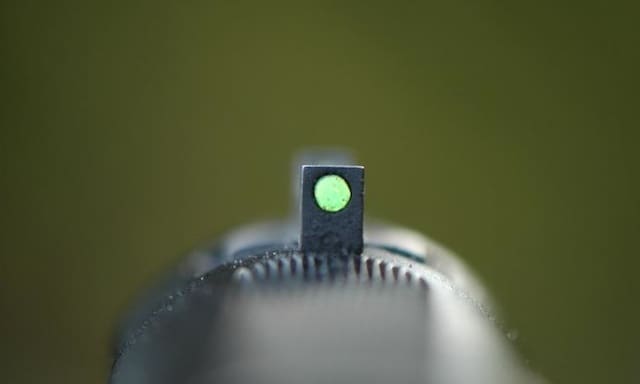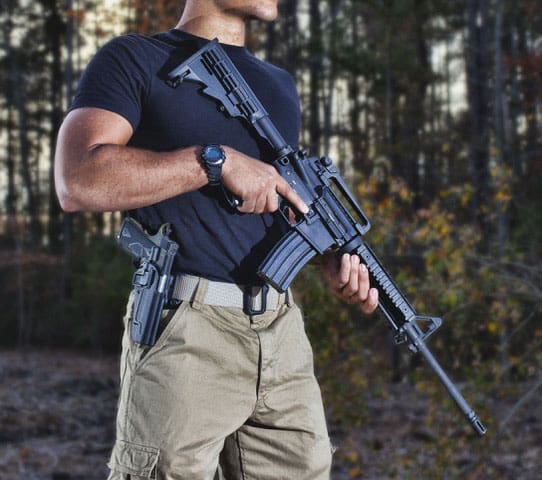Years ago, when I was a new shooter, I had the good fortune to shoot at the Phoenix Rod & Gun Club’s public range. There I met a man who changed my life: “Coach” Pat Dolan. He was a Bullseye shooter, Korean War vet, Air Force Pistol coach and an Olympic rifle coach. According to his scrapbook, he still held the title for 100 yard pistol shooting. He modestly attributed the accolade to the fact that they’d stopped shooting that course of fire when his name stood at the top of the rankings . . .
If Coach Pat saw someone struggling with a gun, he’d give them a free 15 minute lesson. I received that lesson. In my years of shooting at the Phoenix Rod & Gun Club, I saw him give it to dozens of people. Within a matter of minutes most of them—the ones who listened—transitioned from flailing (barely able to hit the target with their shots) to phenomenal (keeping the bullets in the black). Young, old, men, women, cheap guns, expensive guns. It didn’t matter. If you did what Coach Pat told you, you hit the target.
The world lost Coach Pat Dolan in 2005. Many of his students are still trying to “pay it forward.” I appreciate the opportunity to do it here on The Truth About Guns. Shooting pistols is actually rather simple, but without these fundamentals, it’s easy to spend thousands of dollars on guns and ammunition with very little satisfaction in return. There are three fundamentals to shooting accurately, and a trick.
1. Sight picture
Ever since humans started throwing rocks at food, it’s been natural instinct to focus on the target. But with a handgun, the front sight determines where your shot will land.
Line the sights up with each other, and with the target. Place the front sight in the notch of the rear sight. Line-up the top of the front blade level with the top of the rear sight. Clear and even amounts of light should be visible on either side of the front sight blade. Focus on the front sight. The target and the rear sight will be slightly blurry, but that’s ok.
For target shooting use a 6 o’clock hold on a bullseye target. If the bull was a clock, you’d be just touching the bottom at the 6 o’clock position with the top of your front sight. Holding the sights against the white part of the target gives you more light, higher contrast, and finer aim.
A combat pistol will generally be zeroed for a center hold, so to hit the bullseye, you will want to cut the black in half with the sights. However, it’s easy to let black sights wander against a black target. So, when shooting for groups, use a 6 o’clock hold anyway, and simply accept that the group will be centered on the bottom of the target. Or use a small (1″) black Shoot-N-C sticker or black dot drawn with a Sharpie on a plain white piece of paper as a high-contrast aiming point.
The point is not necessarily to hit the aiming point, but to put all your shots through the same ragged hole. Once you can accomplish that, adjust your sights so that hole is on the aiming point.
Too many people start cranking their sights around before they can shoot a precise, repeatable group. Watching someone continually fiddle with their sights was one of the cues Coach Pat would take to step in and offer a lesson.
2. Trigger control
Press the trigger with the pad of your index finger. Not the tip, not the joint. Take up the slack (most triggers have some) and then smoothly press the trigger straight backward, parallel to the barrel. Do not try to make the gun fire. Just smoothly add pressure until it breaks. As Coach would often say, “Smooooth, not smoo-OOTH!”
3. Follow through. When the gun fires, you should be so focused on the front sight that it takes you by surprise. You will see the muzzle flash. Hold the trigger back. Regain your sight picture, then reduce pressure on the trigger until it resets. Do not look at the target to see where you hit, keep your focus on the front sight. Go to #1. Repeat.
The Trick
You have to do #1 and #2 at the same time. Most people will obtain their sight picture, and then apply pressure to the trigger in two separate steps. In the process, they will lose the sight picture, either blinking and jerking, or allowing their focus to slide out to the target. You must maintain the sight picture while applying pressure to the trigger.
That’s it. That’s all there is. You do those three things, and do the first two simultaneously, and you will put your shot right in the 10 ring every single time.
As an added bonus, if you are practicing proper follow-through, letting the trigger up just enough to reset it, and not allowing your focus to drift to the target, you will find yourself shooting rather rapidly. There is a natural rhythm. “Front sight, front sight, front sight.” As you become more comfortable, this becomes “Front, front, front,” with each shot breaking as you find it.
As another great shooting coach, Jerry Miculek says, “My front sight is my throttle.” The speed at which you can find your front sight determines the speed at which you can accurately shoot. Don’t try to outrun your front sight. Just find it faster. This is where fiber optic and other high-visibility sights are invaluable.





What about 2 eyes open in a true combat situation? Does that front sight in focus still apply? My father taught me to shoot 2 eyes open(pistol or rifle). He was in combat in Europe WW2 and taught me that 2 eyes open could save your life in combat.
A good idea, as long as you can still get a good sight picture. We all have a dominant eye, as well as a dominant hand, and will naturally take a sight picture with that eye, even if both eyes are open. People who have nearly “ambidextrous” eyes might need to squint a little (or use a patch on the range) to physically select which eye to use. But most of us can keep both eyes open, and should.
My trick is to use scotch tape inside shooting glasses on range until they forget. the brain is trained by then what to pay attention to and tape is no longer needed.
I’ve seen a lot of people use tape on the shooting glasses, but since I’ve never needed it myself, I wasn’t aware that it could have lasting effects. Good to know, thanks!
Great article!
Yes, same principles for shooting with both eyes.
Shooting for defense uses the same principles except that the situation usually dictates that we pace ourselves faster!
I picked up an FN-FAL with iron sights that were completely out of whack which a friend just bought and shot a 5 inch group at 100 yards, completely off the intended placard onto the adjacent board. My buddy laughed at how badly I missed and I corrected him that I didn’t miss, the gun did. Just a short time and box of ammo later and we were knocking the middle out every time. It’s easy to chase the rabbit down a hole.
Thanks for the info, more is always good. I still tend to pull left, something I’m working on, so reminders and advice like this always helps.
That’s generally a result of muscling a gun, which is a good indicator of high testosterone levels. Congratulations, your shooting indicates that you’re a typical male.
😉
Seriously, women often shoot better than men at first, largely because they don’t have this problem. I can’t tell you how many times I saw macho guys leave the range in disgust after Coach taught their girlfriends to outshoot them. Fortunately, testosterone can also make us bloody-minded enough to practice until we overcome our bad habits.
One exercise Coach used to help overcome this bad habit was to make us shoot one-handed, with our ring and pinky fingers held off the grip, squeezing only with the middle finger and thumb. Of course, this is not good for recoil control, but it does demonstrate that you don’t have to strangle the hell out of a gun to make it fire. Relax, let the gun do the work. That’s the whole reason we carry them for self defense: you don’t have to be strong to practice this martial art. We’re using the energy stored in springs and gunpowder to do the job. All we have to do is release it. It’s like letting a dog off a chain. You don’t have to give it an extra push.
Thanks again, I think I’ll give that a go. I don’t doubt that especially after a few shots, I tend to start gripping harder and thus shaking a bit due to exertion and testosterone.
great info definitely.
I haven’t had anything but a blurry view of my front sight since my eyes turned thirty-five, but I still hit what I aim at. The point of focusing on the front sight isn’t just to get the front sight in focus, it’s to force the shooter to NOT focus on the target.
When the focus is on the target and not the sights, it’s called “point shooting.” Some guns point shoot very well, some shooters point shoot very well, but for most people with most guns, if the shooter’s focus is on the target, the gun will misaligned and the shots off-target. Point shooting accuracy improves with practice, but for for punching out paper targets it will never replace “front sight press.”
Thank you for posting this. I can’t tell you how many times I have heard this; yet I still forget about it until I remember, and then the groups tighten up! The explanation is excellent!
Good stuff, Jason. I’m glad to see this make it out of the comments and into a full-on post because it’s absolutely critical information. More in this vein would be appreciated.
JSG
Thank you for passing this information on Jason. I have been strugging some to keep my shoot accurate. Armed with this new found knowedge I will try it out today at my range. Sounds very basic and simple. just as it should. I’ll tell you how I do. Thank you for sharing the coaches advise.
Comments are closed.